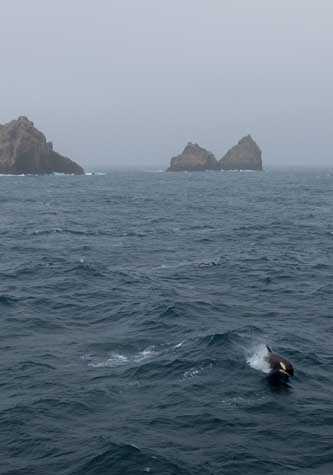The only thing that one can truly expect when embarking on an expedition is that not everything will happen according to plan. Weather changes and wildlife always appear right as lunch is being served. Onboard the National Geographic Explorer “the plan” starts as more of an outline, something of a rough draft with text that is constantly shifting. The only option is to remain flexible and schedule the day around what is happening at that moment, not what sounded like a nice idea several days ago. For example, when it is your turn to write the Daily Expedition Report one must think of what kind of photo to take to accompany it. This can be more challenging during a day at sea because sea birds can’t be counted on to cooperate and hover picturesquely within camera reach, although they very frequently do. Still being very southerly, sunsets and sunrises aren’t as reliably dramatic either, though once again they can be. So when the course for the ship guarantees us passing by the only bit of rock out of several hundred miles of wide-open ocean, aiming to capture an image of what is literally a solid sure thing.
Planning or pre-visualizing photography is an important skill and, as with planning an expedition, usually means that what you set out to do is rarely what ends up happening. The first step in this process is to decide on what lens to use, in this case, attempting to shoot Shag Rock and show its extreme isolation amidst the massive Scotia Sea, a wide angle is most appropriate. This is somewhat of a sacrifice because in doing so one must give up the “reach” of a telephoto lens, so while the reddish spires and encircling seascape can all be in the frame, getting sharp individual images of birds up close is out of the question. While geology is a constant source of interest for all of us, the imagined spectacle of towering stone was not quite as impressive as had been hoped for. Plan in tatters, all seemed lost when suddenly out of the deep blue, a pod of killer whales appeared. These striking cetaceans, the largest of all the dolphins, were so curious they approached the ship. Swimming directly under the bow in such proximity that only a wide-angle lens could fit the whole animal into the frame, which, as blind luck and previously poor planning would have it, there just so happened to be in position. The serendipity of that moment served as a personal reminder that plans don’t fall apart when you’re on an expedition, they evolve. Constantly adapting is how we get to have amazing experiences every day and makes it more than worth being a little late to lunch.




.jpg?width=106&height=85&mode=crop&scale=both&quality=50)


